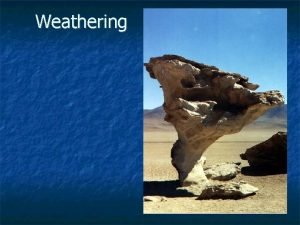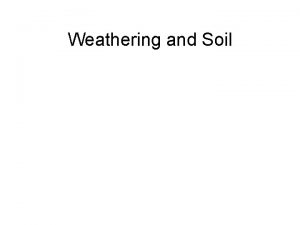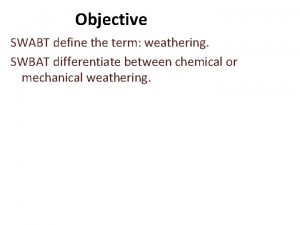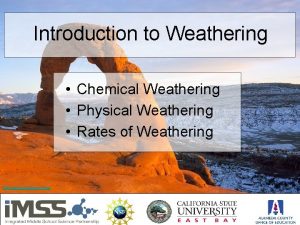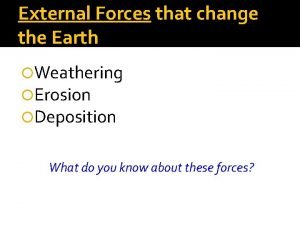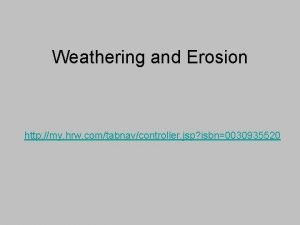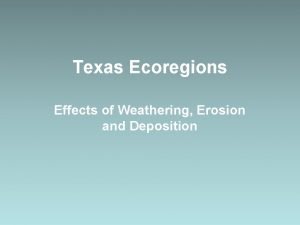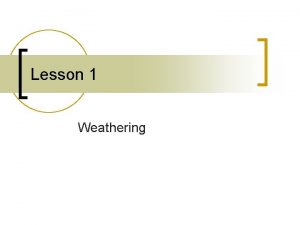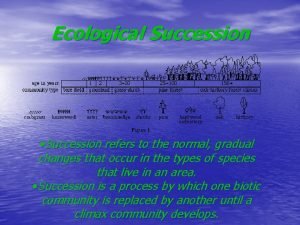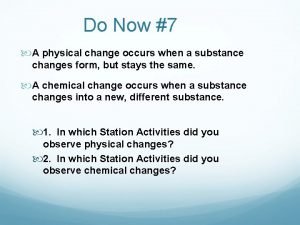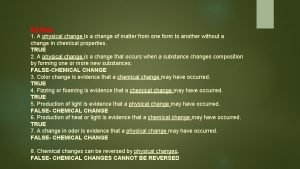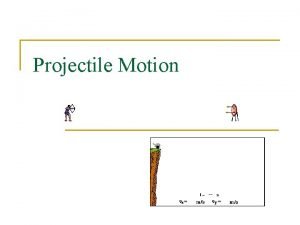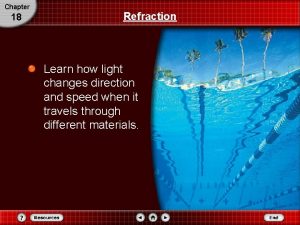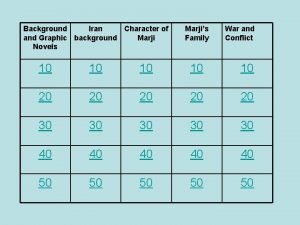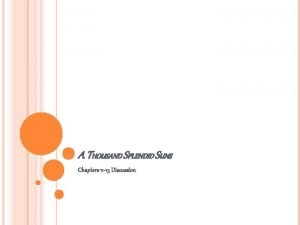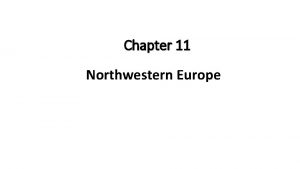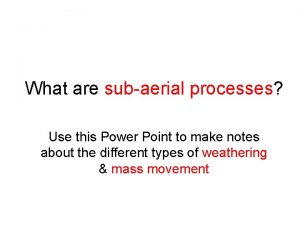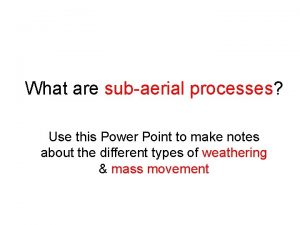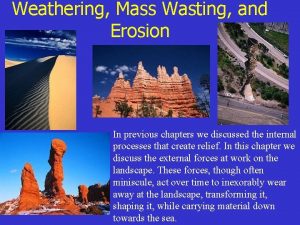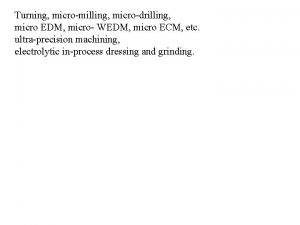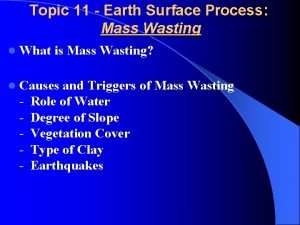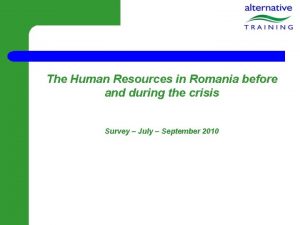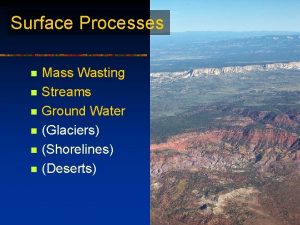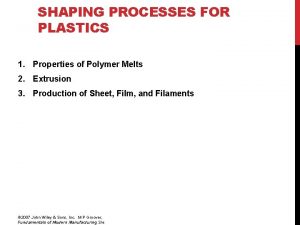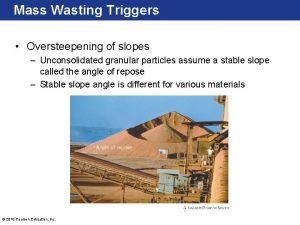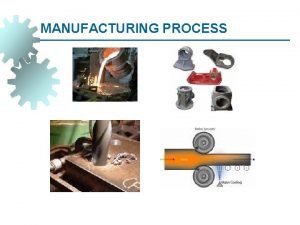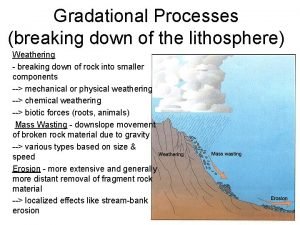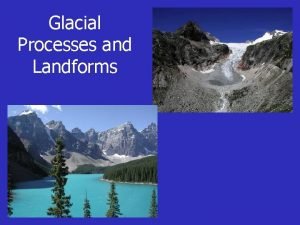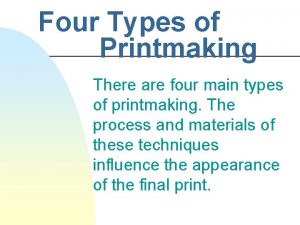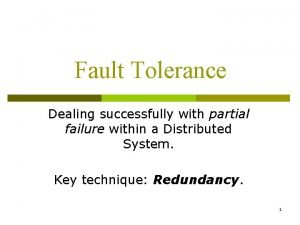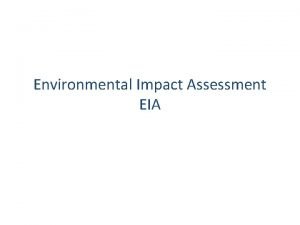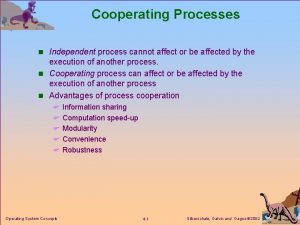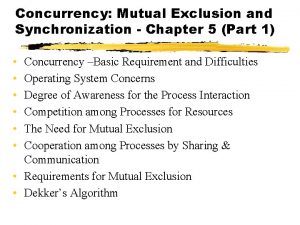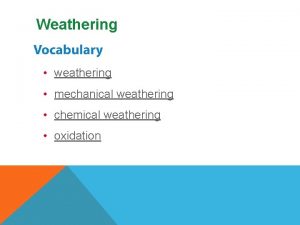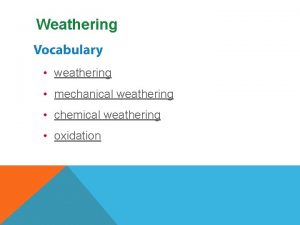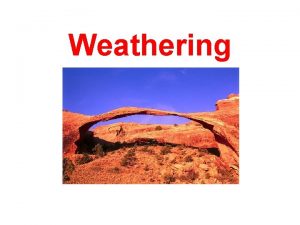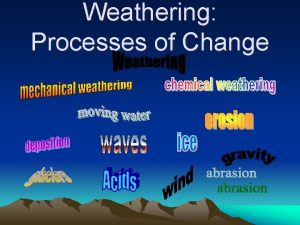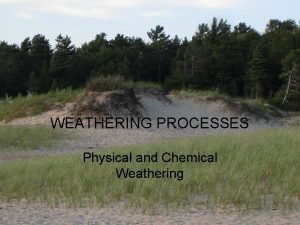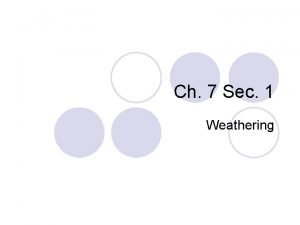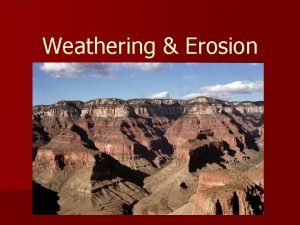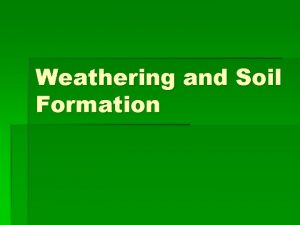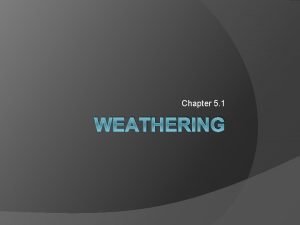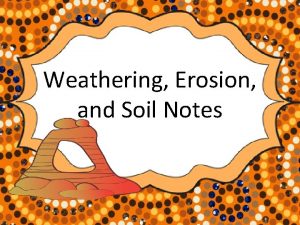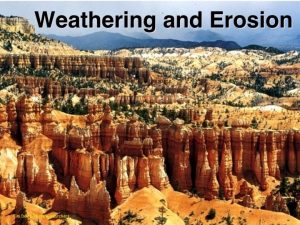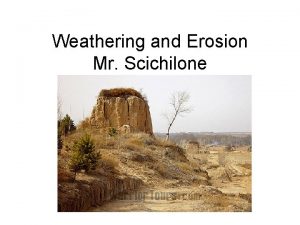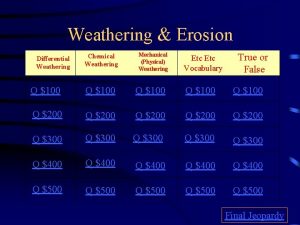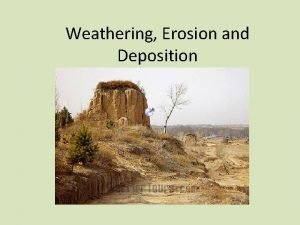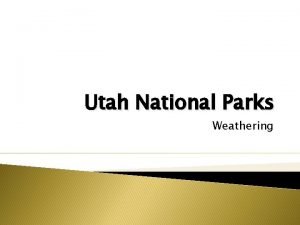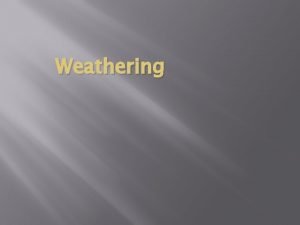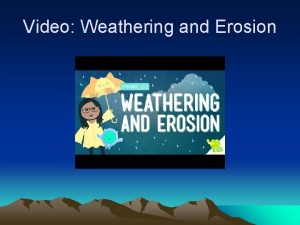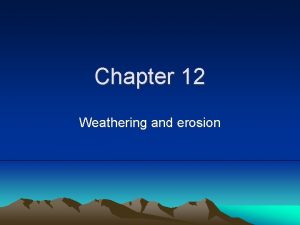Weathering Processes of Change EQ How does weathering







































































































- Slides: 103

Weathering: Processes of Change

EQ: How does weathering occur?

Weathering • Describe three ways abrasion occurs in nature. • List three things that cause chemical weathering of rocks. • Describe the similarity in the ways tree roots and ice mechanically weather rock. • Describe five (5) sources of chemical weathering.

The Processes of Change

Processes of Change (5) • Weathering and erosion wear down, deposition fills in Earth’s surface. • Weathering is the slow wearing away or breaking down of objects exposed to Earth’s atmosphere • Two kinds of weathering act on Earth’s surface – Mechanical weathering – Chemical weathering

Weathering • Weathering is the process by which rock materials are broken down by the action of physical or chemical processes. • Mechanical weathering is the breakdown of rock into smaller pieces by physical means. (ice, wind, water, gravity, plants, animals) • Chemical weathering is the process by which rocks break down as a result of chemical reactions. Water, weak acids, and air can cause chemical weathering.

Mechanical Weathering (4) • When objects are broken down into small pieces but their chemical makeup doesn’t change • Wind and moving water are two main causes of mechanical weathering • Repeated changes in temperature (freeze, melt, freeze, melt again)

Chemical Weathering (5) • Material of an object is changed • Produces underground caverns • Statue of Liberty needed repairs because of chemical weathering • Examples: – Rust (oxidation) – Acid rain (precipitation)

Erosion (5) • The natural moving of material from one place to another • Erosion transports weathered rock material • Causes of Erosion: – Moving water – Gravity – Wind – Glaciers (moving rivers of ice) – Waves

Deposition (5) • Land torn down in one place is “deposited” in another place • Gravity can cause a landslide moving mud, rock and soil down a hill • Wind erosion can move sand deposit it in another area • Glaciers (rivers of ice) scrape rocks off the land moves them downhill

• Glaciers will stop moving and even retreat and cut a steep U-shaped valley in the land

• Erosion caused by mountain rivers form Vshaped valleys

• Hurricanes create waves that erode beaches and cliffs

• Breaking of waves on a beach can wear it away. The larger the waves, the faster the rate of erosion.

6 Agents of Mechanical Weathering • 1. Water – as rocks and pebbles roll along the bottom of flowing water, they bump and scrape against each other, causing these rocks to become rounded and smooth. • 2. Wind – wind blows sand silt against exposed rock eventually wearing away the rock’s surface. • 3. Gravity – rocks grind against each other during a rock slide, creating smaller and smaller rock fragments. Anytime one rock hits another rock, abrasion takes place.

Frost Action • 4. Ice – water seeps into cracks during warm weather. When the temperature drops, the water freezes and expands, causing the ice to push against the sides of the crack. This causes the crack in the rock to widen eventually braking the rock apart.

Ice Wedging

Plants and Animals • 5. Some plants can easily break rocks. The roots grow through existing cracks in rocks. The growth causes the root to expand, forcing the crack to widen. The force can eventually split the rock apart. • 6. Animals that live in the soil (moles, prairie dogs, insects, worms, gophers), cause a lot of weathering. By burrowing in the ground, these living creatures brake up soil and loosen rocks to be exposed to further weathering.

Weathering: Plants and Animals

Abrasion • Abrasion – the grinding and wearing away of rock surfaces through mechanical action of other rock or sand pebbles. • Three ways abrasion occurs: 1. wind 2. water 3. gravity

The Causes of Abrasion

Agents of Mechanical Weathering The breaking down of rock through physical means

Flowing Water Flowing water causes rock on the bottom of a river to bump and grind against each other breaking them into smaller pieces. The rocks become rounded and smooth.

WIND wind blows sand silt against exposed rock eventually wearing away the rock’s surface.

GRAVITY Rocks grind against each other during a rock slide, creating smaller and smaller rock fragments. Anytime one rock hits another rock, abrasion takes place.

ICE Water seeps into cracks during warm weather. When the temperature drops, the water freezes and expands, causing the ice to push against the sides of the crack. This causes the crack in the rock to widen.

Animals that live in the soil (moles, prairie dogs, insects, worms, gophers), cause a lot of weathering. By burrowing in the ground, these living creatures break up soil and loosen rocks to be exposed to further weathering

PLANTS The roots grow through existing cracks in rocks. The growth causes the root to expand, forcing the crack to widen. The force can eventually split the rock apart.

3 Agents of Chemical Weathering • These (3) agents weaken the bonds between minerals grains of the rock.

3 Agents of Chemical Weathering • 1. Water – can cause rock to be broken down and dissolve. Can take thousands of years to take place. • 2. Air – the process of oxidation is a chemical reaction in which an element (iron) combines with oxygen, causing rust. • 3. Weak Acids – Includes: – acids in precipitation – acids in Groundwater – acids in living things

Weak Acids in Living Things Lichens, which consist of fungi and algae, living together, contribute chemical weathering Acids in Precipitation Rain, sleet, or snow that contains more acid than normal • Acids in Groundwater (forming a karst feature, known as a cavern)

Three Sources of Weak Acids • Acid Precipitation – rain, sleet, or snow that contains a high concentration of acid. Normal precipitation is acidic, acid precipitation contains more acid than normal. • Acids in Groundwater – carbonic acid or sulfuric acid reacts with rocks in the ground, causing a chemical reaction, eating away at the rock. • Acids in Living Things – Lichens produce acids that slowly break down rock.

Agents of Chemical Weathering The break down of rock through chemical reactions.

Water Can cause rock to be broken down and dissolve. Can take thousands of years to take place.

AIR The process of oxidation is a chemical reaction in which an element (for example iron) combines with oxygen, causing rust.

Acid Precipitation (weak acid) Rain, sleet, or snow that contains a high concentration of acid. Normal precipitation is acidic, acid precipitation contains more acid than normal.

Acids in Groundwater (weak acid) Carbonic acid or sulfuric acid reacts with rocks in the ground, causing a chemical reaction, eating away at the rock. This is a karst landscape.

Acids in Living Things (weak acid) Lichens produce acids that slowly break down rock by chemical means.

Summary • Wind, water, and gravity cause mechanical weathering by abrasion. • Ice wedging is a form of mechanical weathering in which water seeps into rock cracks and then freezes and expands. • Animals and plants cause mechanical weathering by turning the soil and breaking apart rocks. • Water, acids, and air chemically weather rock by weakening the bonds between mineral grains of the rock.

Quick Check Which of the following things cannot cause mechanical weathering? A. water B. acids C. wind D. animals

Quick Check Which of the following is a type of frost action? A. abrasion B. oxidation C. ice wedging D. gravity

Quick Check Which of the following types of chemical weathering causes a karst landscape, such as a cavern? A. lichens B. acid precipitation C. acids in groundwater D. water

Quick Check How do lichens slowly break down a rock? A. by abrasion B. by mechanical means C. by ice wedging D. by chemical means

Quick Check Which of the following will most likely experience oxidation? A. tennis ball B. aluminum can C. wooden fence D. Bicycle tire

Quick Check 1. The grinding and wearing away of rock surfaces through the mechanical action of other rock or sand particles 2. Rain, sleet, or snow that contains a high concentration of acids 3. The process by which rocks break down as a result of chemical reactions 4. The breakdown of rock into smaller pieces by physical means 5. A chemical reaction in which an element, such as iron, combines with oxygen to form an oxide 6. The process by which rock materials are broken down by the action of physical or chemical processes a. mechanical weathering b. oxidation c. weathering d. acid precipitation e. abrasion f. chemical weathering

Rates of Weathering • What is differential weathering? • How does surface area affect the rate of weathering? • How does climate affect the rate of weathering? • Why do mountaintops weather faster than rocks at sea level?

Differential Weathering • Differential weathering is a process by which softer, less weather resistant rocks wear away and leave harder, more weather resistant rocks behind. • Hard rocks weather more slowly than softer rocks.

Devils Tower appears as it does today because of differential weathering. As surrounding rock was worn away, the hard rock of the tower was exposed. Devils Tower

The Shape of Rocks • Weathering takes place on the outer surface of rocks. • The more surface area exposed to weathering, the faster the rock will be worn down. • As the surface area increases, the rate of weathering also increases. • If a large rock is broken into smaller pieces, weathering of the rock happens much faster. • The rate of weathering increases because a smaller rock has more surface area to volume than a larger rock. • More of the smaller rock is exposed to the weathering process.

Total Surface Area to Volume

Weathering and Climate • The rate of chemical weathering is faster in warm, humid climates than cold, dry climates because of oxidation. • Oxidation happens when the temperature is higher and when water is present. • Water increases the rate of mechanical (physical) weathering (ice wedging). • Repeated changes in temperature (freeze, thaw, freeze, thaw) is a major factor in mechanical weathering.

Warm, Humid Climate vs. Dry Climate

Weathering and Elevation • Mountaintops weather faster than rocks at sea level because they are exposed to more wind, rain, and ice than rocks at sea level or lower elevations. • The increase in wind, rain, and ice increases the effects of mechanical and chemical weathering. This increase in elevation causes peaks of mountains to weather faster. • Gravity affects the rate of weathering: – – – Steepness Rainwater Removal of sediment exposes new rock to weathering Abrasion Increased surface area of mountain

Weathering and Elevation The Ice, Rain, and Wind that these mountain peaks are exposed to cause them the weather at a fast rate.

Summary • Hard rocks weather more slowly than softer rocks. • The more surface area of a rock that is exposed to weathering, the faster the rock will be worn down. • Chemical weathering occurs faster in warm, humid climates. • Weathering occurs faster at high elevations because of an increase in ice, rain, and wind.

Quick Check Small rocks weather more quickly than large rocks because their surface area is a. b. c. d. thinner. smaller. larger. thicker.

Quick Check The average weather condition in an area over a long period of time is called a. b. c. d. temperature. climate. weather. humidity.

Quick Chemical weathering is most rapid in areas that are a. hot and dry. b. warm and wet. c. cold and dry. d. cold and wet.

Quick Check Which rocks are exposed to more wind, rain, and ice? a. rocks at a lower elevation b. rocks in a warm, humid climate c. rocks in streams d. rocks at a higher elevation

Quick Check What three factors determine the rate at which rock weathers? 1. 2. 3.

Quick Check The process by which softer, less weather resistant rocks wear away and leave harder, more weather-resistant rocks behind is called A. B. C. D. mechanical weathering chemical weathering differential weathering acid precipitation

Quick Check Weathering takes place A. B. C. D. at different rates on the outer surface of rocks. on all rocks equally. inside the rocks.

Quick Check Because of a large rock’s volume, it will A. B. C. D. weather unevenly. weather relatively quickly. not weather at all. weather relatively slowly.

Quick Check What is the average weather condition in an area over a long period of time called? ________

Quick Chemical weathering such as oxidation occurs more quickly in a climate that is ______ and ________. 1. 2.

Quick Check Weathering occurs faster at high elevations because of A. B. C. D. an increase in wind but not ice or rain. an increase in ice and rain but not wind. a decrease in wind, ice, and rain. an increase in wind, ice, and rain.

From Bedrock to Soil • What is soil formed from? • What is bedrock • What is humus? • What are soil horizons?

The Source of Soil • Soil is a loose mixture of small mineral fragments, organic matter, water, and air that can support the growth of vegetation. • Bedrock is the layer of rock beneath soil. • Parent rock is the rock formation that is the source of soil. • Soil that is blown or washed away from its parent soil is called transported soil. • Wind, water, and movements of glaciers can transport or move soil from one place to another.


Soil Properties • Soil is made from different-sized materials. • Soil texture is the soil quality based on the proportions of soil particles. • Soil texture can influence the ability of water movement through the soil. • Soil structure is the arrangement of soil particles. • Consistency describes a soil’s ability to be worked and broken up for farming. • Infiltration is the ability of water to move through soil.

Soil Properties • Some soils are rich in nutrients, some are poor in nutrients. • Soil fertility is the soil’s ability to hold nutrients and to supply nutrients to a plant. • Humus is the dark, organic material formed in soil from the decayed remains of plants and animals.

Soil Texture

Soil Horizons • Soil horizons are the horizontal layers of soil. • The top layer of soil is called topsoil, containing more humus than the other layers of soil, rich in nutrients plants need to be healthy. • Good topsoil is necessary for farming.

Leaching

Soil p. H • Soils can be acidic or basic. • The p. H scale, ranging from 0 to 14, is used to measure the acidity of a substance. • 7 is neutral; below 7 is acidic; above 7 is basic. • Different plants need different types of soil. • The right p. H for a soil depends on the plants growing in it.

Soil p. H Scale

Summary • Soil (loam) is formed from the weathering of bedrock. • Soil texture affects how soil can be worked for farming and how well water passes through it. • The ability of soil to provide nutrients so that plants can survive and grow is called soil fertility. • The p. H of a soil influences which nutrients plants can take up from the soil. • Different climates have different types of soil, depending on the temperature and rainfall.

Quick Check 1. Soil that is blown or washed away from its parent rock 2. The layer of rock beneath the soil 3. A rock formation that is the source of mineral fragments in the soil 4. A loose mixture of mineral fragments, organic material, water, and air that can support vegetation a. soil b. transported soil c. parent rock d. bedrock

Quick Check 1. Soil quality based on the proportions of soil particles 2. The arrangement of soil particles 3. Ability of water to move through soil 4. Soil’s ability to be broken up for farming a. soil structure b. infiltration c. consistency d. soil texture

Quick Check What is soil’s ability to hold nutrients and to supply nutrients to a plant? a. b. c. d. Soil structure Soil texture Soil horizons Soil fertility

Quick Check What do we call the removal of substances from soil due to water passing through it? a. b. c. d. Wedging Infiltration Erosion leaching

Quick Check What is the layer of soil that often contains the most humus? a. b. c. d. Horizon Parent rock Topsoil bedrock

Quick Check What is soil that has a p. H below 7 called? a. b. c. d. Neutral Acidic Basic midpoint

Quick Check What is the correct p. H for growing plants? a. b. c. d. 7 Above 7 Below 7 It depends upon the plant

Soil Conservation EQ: How can we conserve our soil?

The Importance of Soil • Soil provides minerals and other nutrients to plants. (1) • Without nutrients, plants cannot grow. • All animals get their energy from eating plants or eating animals that eat plants. • If plants do not get their nutrients from the soil, animals cannot get their nutrients from the plants

Why is soil important?

Housing and Water Storage • Soil provides a place for animals to live. (2) • The area where plants and animals live is called a habitat. • If the soil disappears, then so does the habitat. • Soil stores water for plants. (3) • Without soil to hold water, plants cannot get the moisture of nutrients they need to survive.

Soil Damage and Loss • Soil loss is a serious problem around the world. • Soil damage and loss can come from overuse or poor farming techniques. • Plants cannot grow in soil that is infertile. • Without plants to hold soil in place the area can become a desert – Desertification and land degradation

Providence Canyon in Georgia, has suffered soil erosion from the cutting of forests for farmland.

Soil Erosion • Without plants, soil can be blown or wash away. • If soil is left unprotected, it can be exposed to erosion • Erosion is the process in which water, wind, or gravity transports soil or sediment from one location to another. • By taking care of vegetation, you also take care of the soil.

Soil Conservation Techniques • Contour Farming – to prevent erosion on a hill, the rows of plants act as a series of dams instead of a series of rivers. • Terracing – on a steep hill, terracing changes the a steep hill into a series of smaller, flatter fields. • No-till Farming – the practice of leaving old stalks, providing cover from rain. • Cover Crops – crops that are planted between harvests to replace certain nutrients and prevent erosion.

Soil Conservation Techniques

Summary • Soil conservation is the method in which soil is protected from erosion and nutrient depletion. • Soil is important for plants to grow (1), for animals to live in (2), and for water to be stored (3). • Soil erosion and soil damage can be prevented by no-till farming, contour plowing, terracing, using cover crops, and practicing crop rotation.

Quick Check In your own words, what is the definition of soil conservation?

Answer Soil conservation is a method used to protect soil from erosion and nutrient depletion.

Quick Check In your own words, what is a definition for erosion?

Answer Erosion is a process by which soil is moved or transported from one location to another location by wind, water, or gravity.

Quick Check Practicing which of the following soil conservation techniques will replace nutrients in the soil? a. b. c. d. Cover crop use No-till farming Terracing Countour plowing

Quick Check What are three (3) important benefits that soil provides?

Answer Soil importance: 1. provides minerals and nutrients to plants, 2. provides housing for animals, 3. stores water. 4. solid surface to walk upon

Quick Check List five (5) methods of soil conservation, and describe how each helps prevent the loss of soil.

Answer 1. Crop rotation – slows down nutrient depletion, because different crops use different nutrients 2. Contour Plowing – plowed rows across a slope act as a series of dams to prevent erosion 3. Terracing – prevents erosion by diving a hillside into a series of flat fields 4. No-till Farming – prevents erosion from water runoff by leaving cover the soil 5. Cover Crops – prevents erosion from water runoff by providing cover for the soil
 Concurrent processes are processes that
Concurrent processes are processes that Physical change
Physical change Baking chemical change
Baking chemical change Physical weathering and chemical weathering venn diagram
Physical weathering and chemical weathering venn diagram What is weathering explain the types of weathering
What is weathering explain the types of weathering Types of weathering
Types of weathering Mechanical weathering chemical weathering
Mechanical weathering chemical weathering Weathering is an example of an external force of change
Weathering is an example of an external force of change Weathering summary
Weathering summary Weathering in the piney woods
Weathering in the piney woods How does ice affect weathering
How does ice affect weathering Piney woods deposition
Piney woods deposition How does weathering affect blackland prairies
How does weathering affect blackland prairies What are the four types of chemical weathering
What are the four types of chemical weathering Carbonic acid is a mixture of brainpop
Carbonic acid is a mixture of brainpop Is painting a wall a physical change
Is painting a wall a physical change Chemical change
Chemical change Absolute change and relative change formula
Absolute change and relative change formula What is integers in maths
What is integers in maths Difference between chemical and physical change
Difference between chemical and physical change A change in supply vs a change in quantity supplied
A change in supply vs a change in quantity supplied Supply and demand curve shifts
Supply and demand curve shifts Enagic founder
Enagic founder Proactive vs reactive change
Proactive vs reactive change Physical and chemical changes examples
Physical and chemical changes examples Spare change physical versus chemical change
Spare change physical versus chemical change Rocks change due to temperature and pressure change
Rocks change due to temperature and pressure change Whats the difference between physical and chemical change
Whats the difference between physical and chemical change First-order change
First-order change Is paint drying a chemical change
Is paint drying a chemical change Climate change 2014 mitigation of climate change
Climate change 2014 mitigation of climate change Melanie franklin
Melanie franklin Reaction enthalpy
Reaction enthalpy Ecological succession refers to
Ecological succession refers to Is dissolving salt in water chemical or physical change
Is dissolving salt in water chemical or physical change When does a physical change occur? *
When does a physical change occur? * Eye punnett square
Eye punnett square Table 2.1.3 horizontal motion description
Table 2.1.3 horizontal motion description When does a physical change occur? *
When does a physical change occur? * Passive voice wash
Passive voice wash Arin kisses james
Arin kisses james How does light change direction
How does light change direction How does marji's relationship with god begin to change
How does marji's relationship with god begin to change How does sheila change in an inspector calls
How does sheila change in an inspector calls How do mariam and rasheed observe ramadan differently?
How do mariam and rasheed observe ramadan differently? Two ways to change worksheet
Two ways to change worksheet To kill a mockingbird page 174 line 8 word 3
To kill a mockingbird page 174 line 8 word 3 How does climate change affect us
How does climate change affect us Northwestern europe countries
Northwestern europe countries Law of conservation of mechanical energy
Law of conservation of mechanical energy Touching spirit bear chapter 18 questions and answers
Touching spirit bear chapter 18 questions and answers Why does george wilson lock myrtle in the bedroom
Why does george wilson lock myrtle in the bedroom Does the lens change shape
Does the lens change shape How many psychologists does it take to change a lightbulb
How many psychologists does it take to change a lightbulb Proximal processes
Proximal processes Multiple process in word formation
Multiple process in word formation Study of behavior and mental processes
Study of behavior and mental processes Reading processes
Reading processes Sub aerial processes
Sub aerial processes Sub aerial processes
Sub aerial processes Mass wasting
Mass wasting Micro machining processes
Micro machining processes Landslides caused by earthquakes
Landslides caused by earthquakes Wharton risk management
Wharton risk management What are the 7 hr processes?
What are the 7 hr processes? Mass wasting processes
Mass wasting processes Artynoids
Artynoids High shear
High shear Proximal processes
Proximal processes Generic functions of public administration
Generic functions of public administration Oa air washer
Oa air washer Behavior patterns or mental processes that interfere
Behavior patterns or mental processes that interfere Phonological processes
Phonological processes Transformation process in operations management
Transformation process in operations management Example of morphological process
Example of morphological process Mita business processes
Mita business processes Hot working vs cold working
Hot working vs cold working What are the 4 market forms of meat
What are the 4 market forms of meat Oversteepened slopes
Oversteepened slopes Manufacturing processes for engineering materials 5th
Manufacturing processes for engineering materials 5th In production process
In production process Life processes
Life processes Vowel phonological processes
Vowel phonological processes Wbdg rfp
Wbdg rfp Verbal compounds examples
Verbal compounds examples Helena hurme
Helena hurme Gradational processes
Gradational processes Glacial processes
Glacial processes Exogenic processes
Exogenic processes What are the 4 main types of printmaking?
What are the 4 main types of printmaking? Proximal processes
Proximal processes Hide the occurrence of failure from other processes using
Hide the occurrence of failure from other processes using Executive process
Executive process Event management in itil
Event management in itil Eia processes
Eia processes Comprehensive eia
Comprehensive eia Navfac bms processes
Navfac bms processes Algo and amal
Algo and amal Cooperating sequential processes
Cooperating sequential processes Independent process in operating system
Independent process in operating system Dekker's algorithm for n processes
Dekker's algorithm for n processes Complex cognitive processes definition
Complex cognitive processes definition What is community dynamics?
What is community dynamics? Communication integration processes
Communication integration processes



